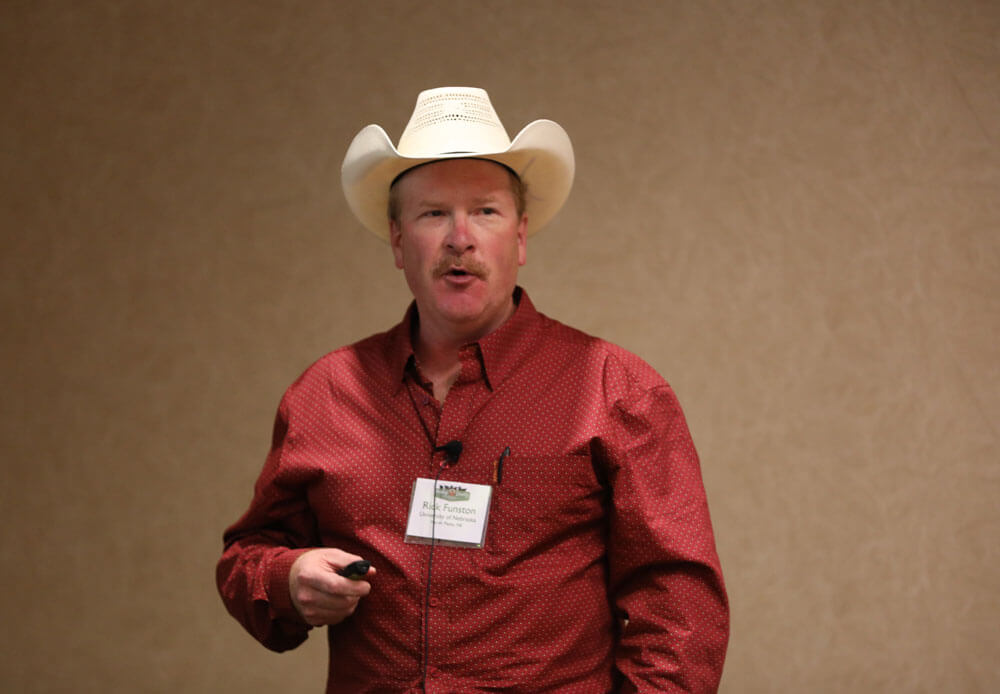
Lower heifer costs, not fertility
by Katrina Huffstutler
It’s a great time to own cows, but only if you have a competitive cost structure with the right genetics and management to compete in today’s marketplace, Rick Funston said.
The reproductive physiologist with the University of Nebraska-North Platte addressed 200 cattlemen at the Feeding Quality Forum this summer in Sioux City, Iowa. While input costs should be minimized in times like these, “breakeven at best” for many, he said, it won’t pay to compromise fertility in the process.
“Fertility is the most important trait in beef production, especially in the cow-calf sector, but all the way to the plate,” Funston said. “If we don’t have a live calf, we don’t have anything for the consumer.”
That’s why he focuses much of his work on replacement female development.
“It’s a huge financial cost before she produces a weaned calf,” Funston said. “We have to look at low input development so we don’t have exorbitant costs for a female that’s difficult to get rebred.”
Relatively cheaper feed such as corn residue may bring slower gains, but he noted that’s often no problem for five-weight weaned heifers that only need to gain 250 pounds.
When the optimum percentage get bred and move on to better nutrition on summer grass, they respond more favorably than their peers developed to a higher weight on better feed. The slower-start heifers rebreed at a higher rate and stay in the herd longer because their diets fluctuate less than heifers given every early feed advantage.

“You feed them up on whatever your byproduct is, get them all pregnant and say, ‘Oh, by the way, you are never going to see that again.’ A lot of our work,” Funston said, “is focused on let’s treat that heifer like she is going to be treated as a cow.”
Aiming for 95% or more bred is folly, he added. “If I can get that, am I really selecting for the more fertile ones?” Better to get cattle to rebreed a few points lower than that, but on low-cost feed such as corn stalks.
Data on early-born steers has shown their advantage from feedyard to packinghouse and beef quality grade, but recent data also shows heifers born in the first 21 days of a calving season are heavier at weaning, gain at the average rate after that and begin cycling before the breeding season. They have a higher pregnancy rate, more in the first 21 days, breed back sooner and wean a heavier calf than average.
Unfortunately, many producers cull the early-born heifers for being too big, not realizing they are simply older.
“This is a mistake,” Funston said, urging adoption of some quick visual tool such as notching ears of those early heifers. “Get rid of those that are born late.”
Heifers most likely to settle the first time and then rebreed on time are more likely to stay in the herd long enough to make a profit.
The forum was presented by the Certified Angus Beef ® (CAB® ) brand, with cosponsors Where Food Comes From, Roto-Mix, Feedlot Magazine, Tyson Foods, Intellibond, Zoetis and Diamond V.
you may also like
Drought Impact and Cattle Industry Dynamics
As drought conditions persist across much of cattle country, farmers and ranchers are at a pivotal juncture in the cattle industry’s landscape. What impact does this prolonged dry spell have on the nation’s herd numbers? When will heifer retention begin? How will industry dynamics influence the spring bull sale season?
Quality Wins, Again
Sara Scott, Vice President of Foodservice for Certified Angus Beef, emphasizes the importance of taste over price in the beef market during the Feeding Quality Forum. As consumer demand for high-quality beef grows, Scott highlights the need for increased supply and encourages communication with packer partners to meet the demand for Prime beef.
Nebraska Ranch Receives Certified Angus Beef Commercial Award
Troy Anderson, managing a Nebraska ranch, focuses on breeding thriving maternal cows that will grade premium Choice and Prime, while respecting livestock, people and land. Anderson Cattle receives the 2023 CAB Commitment to Excellence Award. Their journey includes improving genetics, feeding home-raised and purchased calves and using data for better breeding decisions, all with a bottom-line approach.



